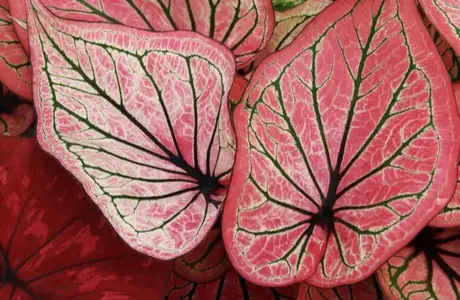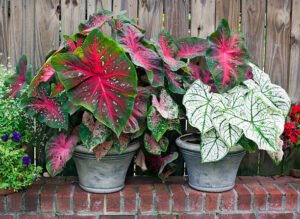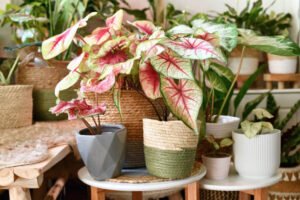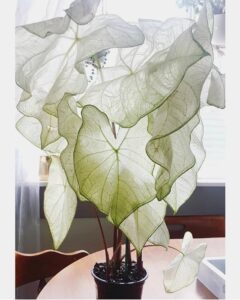Helpful Guides on each Category

Caladium plant (Heart of Jesus) also called the heart of Jesus plant is a genus of flowering plants that belong to the Araceae family native to South America.
These plants are grown for their ornamental leaves, which come in a wide range of colours and patterns, from light green to red, pink caladium, white, and even combinations of these colours.
Because of their attractive foliage, indoors caladiums are foliage plants that make a great part of garden displays.
Caladiums are easy to care for and are perfect for beginners or those who don’t have a green thumb. These plants thrive in warm and humid conditions, and they prefer well-draining soil and bright, indirect light. Caladiums are sensitive to cold temperatures, so they should be kept away from direct sunlight and should be protected from frost.
What Is A Caladium Plant (Caladium bicolor)

Caladium Plant is a popular ornamental plant known for their vibrant, heart-shaped leaves. These tropical plants are native to South America and are often grown as houseplants or outdoor ornamentals in warm, humid climates.
The Heart of Jesus plant popularity is due to its foliage striking beauty and ease of cultivation, making it a favourite among gardeners and plant enthusiasts alike.
One of the most notable features of the Caladium plant is its colourful foliage.
The leaves come in a range of colours, including shades of pink, red, green, and white.
In addition to its aesthetic appeal, the Caladium plant is also believed to have health benefits. Some cultures use Caladium for medicinal purposes, such as treating digestive issues, inflammation, and skin conditions.
However, it’s important to note that the plant is toxic if ingested and should be kept out of reach of children and pets.
Indoors Caladiums are easy to grow. They require a warm, humid environment to thrive.
Also, they prefer partial shade and well-draining soil, making them an excellent choice for gardeners in warm, tropical climates.
Caladium plants are also good houseplants grown indoors in a brightly-lit spot with plenty of humidity.
Caladium (Heart of Jesus) Plant Quick Summary
| Scientific Name | Caladium bicolor |
| Other Common Names | Elephant Ears, Angel Wings, Heart of Jesus plant, Fancy Leaf Caladiums, Lance Leaf Caladiums, Strap Leaf Caladiums, Dwarf Caladiums, Florida Sweetheart, Gingerland, Red Flash, Candidum, Fannie Munson, White Christmas, Pink Beauty, Carolyn Whorton, Scarlet Flame, Pink Symphony, Florida Cardinal. |
| Family | Araceae |
| Origin | South America |
| Growth Rate | Moderate |
| Size | 1-2 feet (30-60 cm) tall and wide. Leaves range from 6-18 inches (15-45 cm) in length. |
| Lighting | Partial shade or filtered sunlight, |
| Soil Type | Well-draining soil rich in organic matter |
| Temperature | Warm temperatures between 70-80°F (21-27°C) |
| Fertilizer | A balanced fertilizer, such as 10-10-10 |
| Toxicity | When Ingested Causes some sort of problems. |
| Planting Zone | high humidity environments. |
| Pests (and diseases) | Leaf spots and root rot. |
Uses And Benefits Of Caladium (Heart of Jesus) Plant

Caladiums are beautiful plants with heart-shaped, colourful leaves that come in a variety of shades, patterns, and sizes.
They are commonly grown for their foliage and can be used for various purposes, including decorating indoor and outdoor spaces, adding texture to gardens, and even promoting a healthy environment.
These are some of the uses and benefits of the Caladium plant:
- Ornamental purposes: Caladiums are primarily grown for their beautiful foliage, which makes them popular in gardens, landscaping, and interior decorating. They are ideal for adding colour, texture, and interest to any space.
- Easy to care for: A huge benefit. Caladiums are relatively easy to care for, making them ideal for novice gardeners. They require minimal watering and can thrive in both indoor and outdoor environments.
- Air purification: Heart of Jesus plants have good air-purifying qualities. They absorb toxins such as benzene, formaldehyde, and xylene, which are commonly found in indoor air, making them ideal for use in homes and offices.
- Natural insect repellent: Caladiums contain a chemical called calcium oxalate, which makes them toxic to insects. This chemical serves as a natural insect repellent, making them a popular choice for gardens and outdoor spaces.
- Medicinal uses: Caladiums are used in traditional medicine to treat a variety of ailments such as snake bites, skin rashes, and digestive issues. However, it is important to note that the plant is toxic when ingested and should only be used under the guidance of a trained professional.
Common caladium (Heart of Jesus) Plant varieties
1. White Queen (Caladium bicolor)
This variety has white leaves with green veins and edges.
2. Candidum (Caladium bicolor)
Has white leaves with green veins and edges, similar to White Queen but with larger leaves.
3. Aaron (Caladium bicolor)
This variety has white leaves with green edges and veins.
4. Fannie Munson Plant (Caladium bicolor)
This variety has green leaves with pink and white spots and a pink centre.
5. Florida Sweetheart (Caladium bicolor)
This variety has heart-shaped leaves with pink centres and green edges.
6. Gingerland (Caladium bicolor)
This variety has green leaves with pink and white speckles and veins.
7. Pink Beauty (Caladium bicolor)
This variety has pink leaves with green edges and veins.
8. Red Belly Plant (Caladium bicolor)
This variety has green leaves with red centres.
9. Red Flash (Caladium bicolor)
This variety has green leaves with bright red veins and speckles.
10. Pink Symphony Caladium (Caladium bicolor)
This variety has green leaves with pink and white spots and veins.
11. Carolyn Whorton (Caladium hortulanum)
This variety has green leaves with pink and white centres and green edges.
12. Frieda Hemple (Caladium hortulanum)
This variety has large green leaves with white and pink spots.
13. Kathleen (Caladium hortulanum)
This variety has heart-shaped leaves with green centres and pink and white edges.
14. Miss Muffet (Caladium bicolor)
This variety has green leaves with pink spots and veins.
15. Scarlett Pimpernel Plant (Caladium hortulanum)
This variety has red leaves with green edges.
16. Postman Joyner (Caladium hortulanum)
This variety has green leaves with white and pink spots and veins.
17. Lord Derby (Caladium hortulanum)
This variety has green leaves with white and pink spots and veins, and pink centres.
18. Firecracker (Caladium hortulanum)
This variety has green leaves with red veins and speckles.
19. White Wing (Caladium hortulanum)
This variety has white leaves with green veins and edges.
20. Moonlight (caladium moonlight)
This variety has green leaves with white and yellow spots and veins.
How to plant caladiums From bulb (step-by-step Guide).

Caladium plants can be propagated using their stem cuttings or caladium bulbs. Below, we will guide you through how to grow caladium plants from the bulbs. This is because Caladium bulbs are the most efficient and easiest way to grow the plant.
- Choose a suitable location: Caladiums prefer partial shade or filtered sunlight, and they grow best in well-draining soil that is rich in organic matter.
- Prepare the soil: Dig a hole that is two to three times wider than the caladium bulb, and mix in compost or peat moss to improve the soil’s nutrient content and drainage.
- Plant the bulbs: Place the caladium bulbs in the hole with the rounded side facing up and the pointed side facing down. The bulbs should be planted about 1-2 inches deep and spaced 8-12 inches apart.
- Cover the bulbs: Cover the bulbs with soil, and gently pat down the soil to remove any air pockets.
- Water the bulbs: Water the heart of Jesus plant bulbs thoroughly after planting to help them settle into the soil.
- Maintain moisture: Keep the soil consistently moist but not waterlogged, as caladiums require regular watering to thrive.
- Fertilize: Apply a balanced fertilizer once a month during the growing season to promote healthy growth and vibrant leaf colour.
- Mulch: Add a layer of organic mulch around the plants to help retain moisture, suppress weeds, and regulate soil temperature.
- Monitor for pests and diseases: Check the plants regularly for signs of pests or diseases, such as spider mites, thrips, or fungal infections, and treat them promptly if necessary.
caladium plant (Heart of Jesus) care.

What is the Best time to plant caladiums? Indoors Caladiums Growing Period
The best time to plant caladiums is in the spring after the last frost date has passed and the soil has warmed up.
In most regions, the growing period is typically in late April or early May. Planting caladiums too early, when the soil is still cold and wet, can result in poor germination and root rot.
If you live in a warmer climate where the soil never freezes, you can plant caladiums in the fall for winter colour. However, if you live in a colder region where frost is a concern, it is best to wait until the spring to plant caladiums.
It’s also important to note that caladiums are tropical plants and do not tolerate cold temperatures or frost. If you plant caladiums too late in the growing season, they may not have enough time to establish their roots and develop their foliage before the first frost, which can damage or kill the plants.
Watering caladiums after planting
Watering is also an important aspect of caring for caladiums. Heart of Jesus plants require regular watering to maintain their foliage and prevent wilting during growth. Choose a location that is easy to access and where you can water the plants regularly.
Lighting and Sunlight Requirements
Caladiums prefer partial shade or filtered sunlight, as direct sunlight can scorch their leaves. Choose a location with dappled shade or morning sun and afternoon shade.
Temperature and Humidity
Caladiums thrive in high-humidity environments, such as those found in tropical or subtropical regions. If you live in a dry climate, consider using a humidifier or misting the plants regularly to increase the humidity level around them.
Being tropical, Heart of Jesus plants prefer warm temperatures between 70-80°F (21-27°C). Avoid planting them in areas that are too cold or exposed to harsh winds.
Soil requirements for planting caladiums
The soil should be kept consistently moist, but not waterlogged, to prevent root rot. It’s best to water your caladiums in the morning, so the leaves have time to dry out before nighttime.
During the dormant period, which occurs during the winter, you should reduce the amount of water you give your caladiums, but they still need to be kept slightly moist.
Caladiums grow best in well-draining soil that is rich in organic matter, such as compost or peat moss. Avoid planting them in heavy clay soil or areas that are prone to flooding.
Fertilizer Application
Another important factor to consider is fertiliser. Caladiums are heavy feeders and need to be fertilized regularly to promote healthy growth and vibrant foliage.
It’s best to use a balanced fertilizer, such as 10-10-10 fertilizer, and to apply it every two to four weeks, depending on the type of fertilizer you use.
Pruning and Maintaining deadheading caladiums
- Caladiums do not require pruning, but you can remove any dead or yellowed leaves to improve their appearance and promote new growth.
- Deadheading is not necessary for caladiums, as they do not produce flowers.
- Use clean, sharp scissors or pruning shears to cut off any dead or yellowed leaves at the base of the stem. This will help to improve the plant’s appearance and prevent the spread of disease.
Caladium Plant Pests And Diseases.

Caladiums are relatively low-maintenance plants, but they can be susceptible to a few pests and diseases. Here are some common pests and diseases that can affect caladium plants:
Pests of Caladium Bicolor plant
- Spider Mites: These tiny pests can cause yellowing and speckling on the leaves. You can control spider mites by spraying the leaves with a mixture of water and insecticidal soap.
- Thrips: These pests feed on the leaves and can cause distorted growth and discolouration. You can control thrips by using a systemic insecticide.
- Snails and Slugs: These pests can damage the foliage and leave slime trails. You can control snails and slugs by handpicking them or using bait.
Diseases of Caladium Bicolor plant
- Leaf Spot: This fungal disease causes brown or black spots on the leaves. You can control leaf spots by removing infected leaves and treating the plant with a fungicide.
- Root Rot: This disease is caused by overwatering or poorly drained soil, which can lead to the roots becoming waterlogged and rotting. You can control root rot by improving soil drainage and reducing watering.
- Bacterial Blight: This disease causes brown, water-soaked spots on the leaves and can cause the plant to wilt. You can control bacterial blight by removing infected leaves and treating the plant with a copper-based fungicide.




